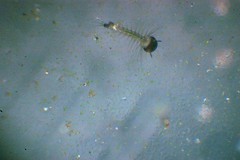Well, all of my mosquitoes have died... in both containers. It was just a small look into the pesticide issue.
But, was it only the pesticide?
We put herbicide and Tylenol and anti-psychotic drugs and mercury and zinc and PAHs ... Then a scum and a slick formed and cyano-bacteria bloomed and fungus formed on the dead mats...
Because all of the fish and insects died in all of the pots, then, two weeks later, mosquitoes laid their eggs and larvae hatched. We really needed to take a look at tolerances and toxicity.... But, we did not have all the time and, oh, that awful stuff... money, to conduct yet another study.... We are still processing all of the other samples.... leaves and stems and roots and water and soil and algae and fish and dragonflies .....
So, ...to just to watch the development of the mosquitoes from the pots... I scooped out enough for two batches (one collected two days after the first).... I realized I did not have enough egg cases, but I would note development and time and conditions and the final result - no matter what happened.
I did not mix the water between the two containers and when evaporation lowed the levels, I re-filled to the original mark with drinking water. Each plastic covered (screened) container had one good egg mass. The first container had very little water about one and a half centimeters deep (cottage cheese container).... The second one had three centimeters of water (same type of container and lid).
Within the first day I had mozzies in the first container. Two days later, the mosquitoes in the second container emerged. Four days after that the second container with the most water, all larvae died.
Looking closer at the differences between the two containers, I noticed that there was a lot of fungal growth on the dragonfly tests (skin left over from emerging larvae) in the second container. The leaves left in the first did not have this fungal growth (both samples came from the same pot). The strands of fungus were long, dark, and almost black, and needle like.
The first container with the first group of mozzies, had clumps of green on the bottom - see the picture. The second container was murky but had either ciliates or flagellates swimming. The first container also had the same types of protozoa but the water was clear. .....Mozzies, for all of their bad rap, filter water of protozoa and algae, so this made sense... but what happened to the second container?
One would think the container with the most water (the second one) would be more successful! Both containers were exposed to some light so that algae could grow. The first container's second batch of mozzies (four times bigger then the first group before they died) fed on the bodies of their brothers and sisters and algae.... The larvae in the second patch only developed to the size of the first batch and then died....
My friend found a paper that described a similar study of a wetland habitat where after adding metals to the water, a bloom of flagellates occurred..... As I recall in marine systems,.... some ocean dinoflagellates can become toxic when stressed. Also, in the marine environment, diatom blooms occur near the outflows from city sewage and urban runoff. Diatoms when stressed (pH changes, exposure to lead and other toxic metals) and deprived of normal river runoff - iron (this is a limiting factor for life in the ocean phytoplankton) - release domoic acid which is neurotoxic to vertebrates. I don't know what kind of flagellates are in our experimental freshwater system, but one wonders....
It's really all about balance isn't it.

No comments:
Post a Comment